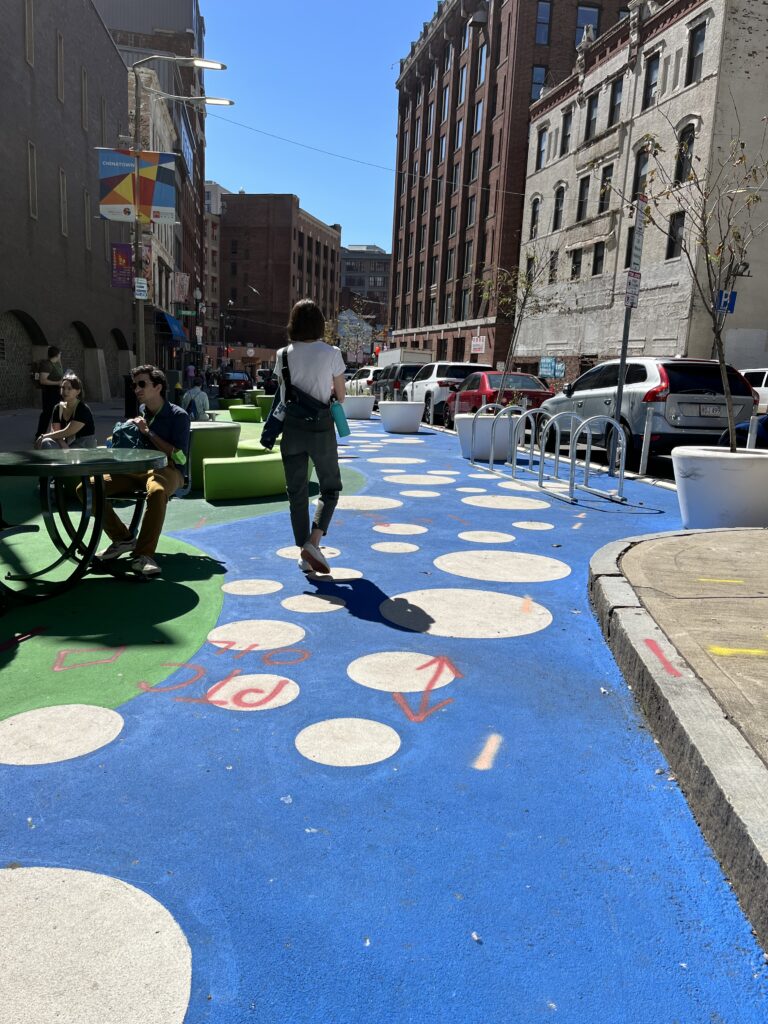MVPC staff attended the National Association of City Transportation Officials (NACTO) Designing Cities conference hosted by the cities of Boston, Cambridge and Somerville on September 7-9, 2022. The conference offered many unique opportunities to learn from transportation planners, advocates, and innovators from a range of U.S. and International cities. Although most of the featured speakers were from cities larger than communities in the Merrimack Valley, MVPC took away lessons and elements that will shape and inspire our work moving forward.
A big thank you to the Barr Foundation for funding the registration fees for the event.
One of the biggest takeaways from the week was the need for political will and grassroots advocacy to swing the momentum in the direction of creating cities for people. Speakers like Mayor Michelle Wu and Congresswoman Ayanna Pressley spoke of their own personal stories as bike commuters, transit riders, and pedestrians, and how their experience influences policies that create transportation equity and justice in the City of Boston and across the nation. Over the course of the conference, we spoke with other attendees and heard from national leaders about strategies for building a transportation network that is safe, equitable, and sustainable.
Safety was at the forefront of many workshops and presentations. It was especially top of mind for MVPC with traffic fatalities on the rise and with the submission of the region’s application for the Safe Streets for All federal grant program in which. MVPC and the Northern Middlesex Council of Government jointly applied for a regional comprehensive safety action planning grant. We walked away from the conference with an enhanced understanding of traffic improvement strategies that will inform our decision making as we hope to undertake this regional initiative.
The workshops covered useful topics such as designing improvements on arterial roads – known to be the most dangerous for pedestrians and cyclists. Designs included employing road diets, separated bike lanes, expanding sidewalks, and improving transit systems to increase safety for all users of the road. In some cases, the intersection designs decreased level of service for cars, but the tradeoff was worth it because it resulted in fewer pedestrian injuries and fatalities at an intersection.
At a workshop on the future of Vision Zero, featured panelists from Hoboken, New Jersey, Toronto, Canada and Madison, Wisconsin discussed their community’s experiences with implementing Vision Zero action plans. All the panelists agreed that a Vision Zero goal and action plan was worth creating because it set a target and a roadmap for all stakeholders to follow. An interesting takeaway from this discussion was the influence that transit can have on reducing traffic fatalities. Buses and trains have greater protection than other modes from impacts, can have dedicated lanes or rails, and they have operators whose job it is to keep everyone onboard safe. Canada has much greater transit ridership than the U.S. (12.4% of commuters in Canada and only 5% in the U.S.) – this could be the reason why Canada is outpacing the U.S. on their way to zero fatalities.
The discussion was especially pertinent as MVPC moves toward planning for Vision Zero in the region in conjunction with our member communities. As we work to make our streets safer, it is important for MVPC and our communities to set goals and have a plan for achieving them. The evidence was clear that it makes a difference – Hoboken, NJ has not had a traffic fatality in over 4 years. They did not have many roadway fatalities before creating their Vision Zero Action Plan, but setting the goal helped them achieve it.
The NACTO Conference escorted the attendees from Hynes Convention Center every day for “walkshops” through the three host cities – MVPC’s Tony Collins ended up walking about 25 miles and biked about 10 miles over the course of three days. One day we walked from Boston City Hall to China Town and explored the pedestrian spaces the city has created by taking away parking spaces, slip-lanes, and underutilized space.
These walkshops reiterated the importance of getting out into our communities and walking the streets, as that is the best way to understand what the street scape is like for non-motorized travel. The city created these spaces using tactical/quick-build materials such as paint, planters, and moveable furniture, as well as hardscaped, permanent infrastructure. The projects create a safer place for people to gather and make the city feel more inviting to visitors. Our communities in the Merrimack Valley have done a few of these projects already and are working on more to come. The approach Boston took to create these places will influence what we do in the future.

Tactical Urbanism Space for People – Chinatown, Boston.

Bike Lane Adjacent to a Public Plaza – Downtown Crossing, Boston.
The need for a clear vision was demonstrated when we visited the site of a new neighborhood in Cambridge, called Cambridge Crossing. It is located at the site of the old Lechmere station and features a mix of land uses – retail, office and lab space, residential and open space – and walking and biking trails throughout. There had been a few developers that came and went, but once the current developer came along, they came with a vision. They were able to turn what was once an industrial “wasteland” into a place that looks like it was taken out of an urban planning textbook. The connectivity that they created throughout the site is something that should be studied by our communities as new development comes to the Merrimack Valley. In all our planning work, the vision that we develop will influence the outcomes in our communities. Having a vision that improves the quality of life for current residents and amplifies the culture of a community will have a great impact and we at MVPC will continue to look for ways to bring this vision into our communities.

Mixed-Use Development with mini soccer field – Cambridge Crossing, Cambridge.
One interesting point that the developer made was the need to get Cambridge Crossing on the “mental maps” of people in Cambridge, Somerville, and Boston. People have their destinations in mind, and there must be a strategy to get people to go to somewhere new. As we build our transportation network to better fit the needs of people in our communities, we should also be thinking about how we can allow people to explore new places. There is still a lot to be explored, but good wayfinding along with comfortable and well-designed facilities invite exploration.

Comfortably Designed Staircase with Greenery – Cambridge Crossing, Cambridge.
The MVPC Transportation Staff learned a lot and heard many different perspectives over the course of the conference. Hearing from planners and sharing our experience made clear that there is no one solution, and the best approach is to work with many people and try new ideas. Even though many of the examples were geared towards larger cities, the strategies, approaches, and thought processes used to create change could be tried anywhere – and they are worth trying. Experiencing the outcome of good planning – planning that involves a variety of perspectives – can invigorate the willingness to try a new idea or concept. As planners for the Merrimack Valley, the Designing Cities Conference instilled the importance of exploring our communities and gathering new perspectives for how we can improve our work.
